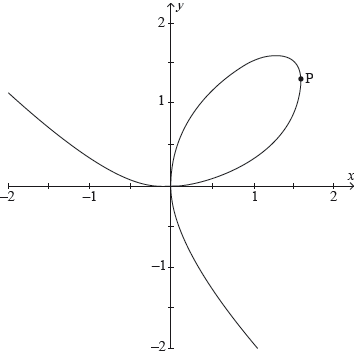| Date | November 2021 | Marks available | 2 | Reference code | 21N.1.SL.TZ0.12 |
| Level | Standard Level | Paper | Paper 1 | Time zone | Time zone 0 |
| Command term | Solve | Question number | 12 | Adapted from | N/A |
Question
The surface area of an open box with a volume of and a square base with sides of length is given by where .
Find .
Solve .
Interpret your answer to (b)(i) in context.
Markscheme
(M1)
Note: Award (M1) for expressing second term with a negative power. This may be implied by seen as part of their answer.
OR A1A1
Note: Award A1 for and A1 for . The first A1 is for differentiated correctly and is independent of the (M1).
[3 marks]
EITHER
any correct manipulation of e.g. (M1)
OR
sketch of graph of with root indicated (M1)
OR
sketch of graph of with minimum indicated (M1)
THEN
A1
Note: Value must be positive. Follow through from their part (a) irrespective of working.
[2 marks]
the value of that will minimize surface area of the box A1
Note: Accept ‘optimize’ in place of minimize.
[1 mark]
Examiners report
In part (a), many candidates scored at least the mark for correctly differentiating although differentiating proved to be more problematic, not realizing that the term could be written as . Some who did realize it, made a mistake while differentiating the negative index. In part (b)(i), the manipulation of the equation was frequently incorrect; those that used their GDC got the correct answer with no working. Many candidates could follow the instruction but where errors were made in part (a), valid solutions for part (b) proved tricky with some negative values seen. In part (b)(ii), a significant number of candidates did not appreciate what is meant by a gradient function equal to zero. Of those who had some idea, the words minimize and maximize were seen but not always in terms of the surface area. Many incorrect answers referred to the volume. Many candidates had difficulty communicating an interpretation of their answer in context. This resulted in several negative answers found for part (b)(i) being left as is, when contextually, negative answers would not make sense.
In part (a), many candidates scored at least the mark for correctly differentiating although differentiating proved to be more problematic, not realizing that the term could be written as . Some who did realize it, made a mistake while differentiating the negative index. In part (b)(i), the manipulation of the equation was frequently incorrect; those that used their GDC got the correct answer with no working. Many candidates could follow the instruction but where errors were made in part (a), valid solutions for part (b) proved tricky with some negative values seen. In part (b)(ii), a significant number of candidates did not appreciate what is meant by a gradient function equal to zero. Of those who had some idea, the words minimize and maximize were seen but not always in terms of the surface area. Many incorrect answers referred to the volume. Many candidates had difficulty communicating an interpretation of their answer in context. This resulted in several negative answers found for part (b)(i) being left as is, when contextually, negative answers would not make sense.
In part (a), many candidates scored at least the mark for correctly differentiating although differentiating proved to be more problematic, not realizing that the term could be written as . Some who did realize it, made a mistake while differentiating the negative index. In part (b)(i), the manipulation of the equation was frequently incorrect; those that used their GDC got the correct answer with no working. Many candidates could follow the instruction but where errors were made in part (a), valid solutions for part (b) proved tricky with some negative values seen. In part (b)(ii), a significant number of candidates did not appreciate what is meant by a gradient function equal to zero. Of those who had some idea, the words minimize and maximize were seen but not always in terms of the surface area. Many incorrect answers referred to the volume. Many candidates had difficulty communicating an interpretation of their answer in context. This resulted in several negative answers found for part (b)(i) being left as is, when contextually, negative answers would not make sense.


